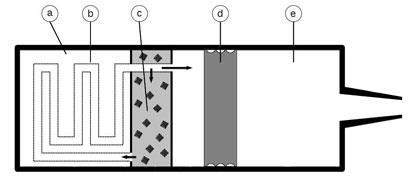A German start up has developed a disposable infusion pump that uses osmosis instead of electrical power
Inspired by how plants transport fluids, a German start up has developed a pump that uses osmosis to deliver a liquid drug without electrical power or mechanical parts. The unusual design of the pump ensures that the osmotic pressure does not drop during operation, leading to a steady flow of the drug into the body. The company, Acuros, says it is the first fully disposable pump of its kind and could be used for a range of drugs, particularly insulin for the treatment of diabetes. Patients with diabetes often use infusion pumps that sit outside the body and steadily deliver insulin via a tube as an alternative to making several injections each day.
The prototype pump is activated by snapping it together. Then, osmotic flow of water from one chamber into another across a membrane causes a build up of pressure. The pressure is transferred to a plunger that pushes the drug out of the pump. The trick is a loop in the system that redistributes fluid around the pump to compensate for the natural drop in osmotic potential (see box).
The pump can produce a steady flow of the drug for several hours or several days, says chief executive Helge Adleff. And, when it’s done, it can simply be thrown away.
How it works
The process starts with osmosis from the water reservoir (a) into the flow channel (b) which contains saline solution from the saline reservoir (c). This increases the volume of fluid and the pressure in the flow channel. The pressure is released by the plunger (d) as it moves into the drug reservoir (e) and forces the drug out of the pump: the end result.

Now, of course, the saline solution in the flow channel should become more dilute and the rate of osmosis should fall. But this doesn’t happen because of a secondary osmotic step, in which a small quantity of water moves from the end of flow channel (now containing diluted saline solution) to the saline reservoir (containing concentrated saline solution). This displaces some of the concentrated saline solution into the start of the flow chamber, keeping constant the potential of the primary osmotic step.
The five person company was spun out of Humboldt University of Berlin in 2006. ’We were working on plant cells,’ says Adleff. ’We had to move liquids through the cell wall - some nanolitres per minute - and there were no pumps available. So we started creating something and my professor saw this and thought: "Hey. That’s cool. There’s actually a demand for micropumps like that."’ He is now looking for pharma industry partners to put the technology into action.
The market for infusion pumps is worth about $6 billion (?3.75 billion) per year, according to a 2010 report from market research firm Kalorama.
Andrew Turley






No comments yet